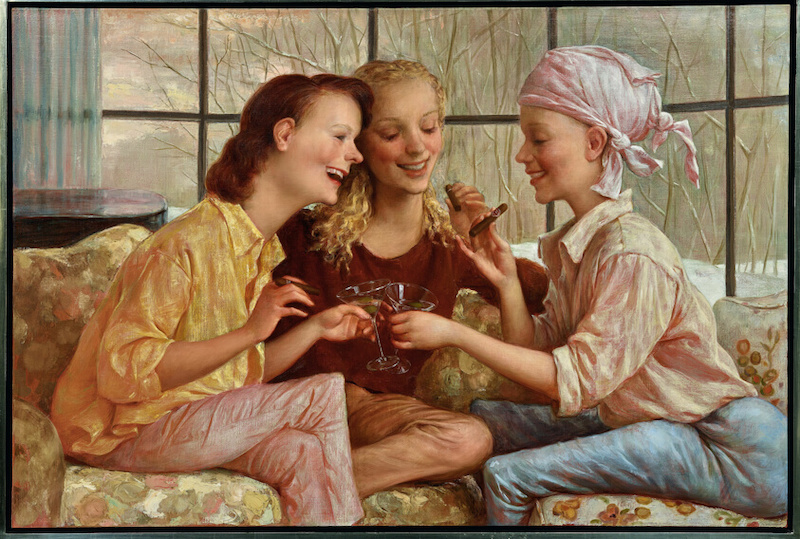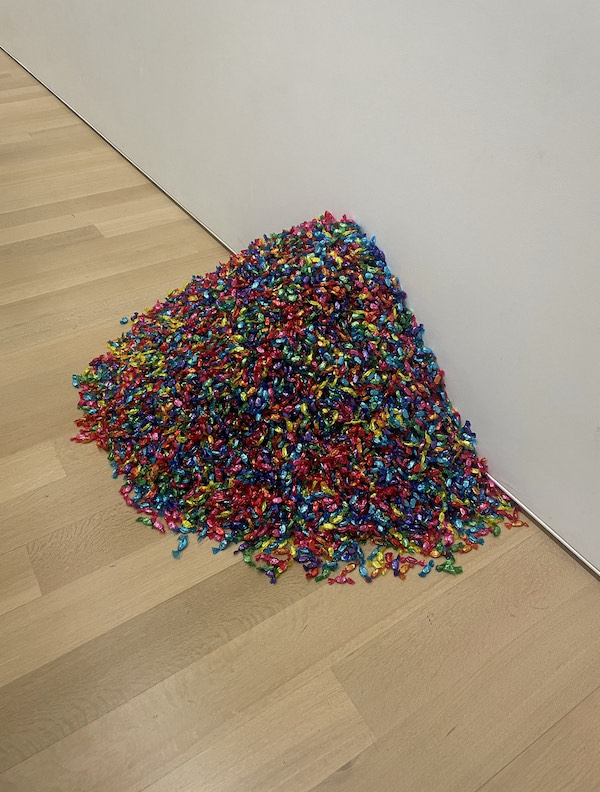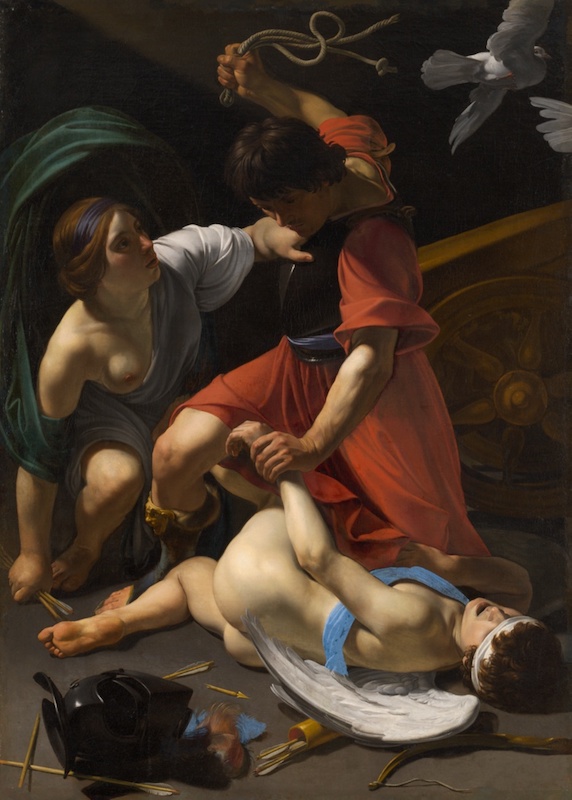Wandering Through Art History In Pursuit of Solace and Hope


Stamford after Brunch, 2000
oil on canvas
40 × 60 in.
Art Institute of Chicago
Gift of Edlis Neeson Collection
By BIANCA BOVA
I have the privilege of working in a museum. The Art Institute of Chicago occupies in my life the role of the definitive museum, by virtue of being the first that I experienced as child and a space that has served as the backdrop to many moments of significance personally and professionally in my adult life. I am lucky in this regard, if, at the moment, in no other.
In a refrain echoed by many of my colleagues, I readily confess to spending less time in the museum's galleries than I should, considering I am already in the building. When my life was beset by bad circumstances last winter, for the first time I made a concerted effort to spend more. I have long held the belief that there are no novel experiences. In the whole unrecorded history of humanity, someone else has undoubtedly encountered just the set of circumstances one finds themself in, albeit arriving there by different means. Likewise, I believe in the canon of art history there is bound to be something that speaks to every human experience; something that reflects it, or that it can be hung on, or pinned to. This is, after all, an argument for why we have museums in the first place, or at the very least, why we collect art. A collector says they “fell in love” with a piece or that they “saw it and just had to have it.” It’s possible that what they saw was dollar signs, or that there is some degree of compulsion at play not dissimilar to the compulsion a gambler feels walking by a blackjack table. It is more in line with my experience, however, that it is a matter of seeing something that calls up some interior aspect of oneself–though, in the heat of that moment, it is seldom clear what aspect–that is the real driver. This abiding belief defines for me, more than any other, the work I do for a living as work worth doing. In an encyclopedic museum like the Art Institute, one generally not need to look too far, either.
*
I began my intentional exploration, as a matter of habit more than anything else, on the second floor of the Modern Wing. There are works there that I have long been in the thrall of, and they now held the promise of stability at a time when I felt the floor perpetually slipping out from under my feet. It was comforting to know I could go up to gallery 296 anytime I wanted, and there, in the same place on the same wall, unchanged would be my favorite work in the whole museum, John Currin’s Stamford After Brunch (whatever judgment that admission earns me I welcome as entirely fair). I know the contents of the Modern Wing 200’s more or less by heart. I have given tours of them. There’s the de Kooning, there’s the Pollack, there’s the Frankethaler, there’s the Mitchell. Old friends. There’s the Robert Gober, perfect and sad and hopelessly attractive, and the Cady Noland that never fails to cause a certain populist shame to rise to the surface. I began going with regularity up to gallery 293 to gather a piece of candy or two from Untitled (Portrait of Ross in L.A.), hoarding them in my desk drawer. After all, what is there to know about the bedfellow relationship between love and grief that can’t be gleaned from Félix González-Torres?

In moments of uncertainty there is always the temptation to return to the well. For me, at the bottom of the well reside an unfortunate pair, F. Scott Fitzgerald and Edward Hopper. When I realized the impact of wandering the Modern Wing 200’s was less the salve I had hoped it would be, I changed route and wandered in the American Art galleries instead. This development only lasted two days, during which Isamu Noguchi’s impossible aluminum Miss Expanding Universe sent me ricocheting back to Ruth Page’s Sex essay, an undated and diary-ish account of her marriage to Thomas Hart Fisher and her affair with Noguchi, and perhaps the most clear-eyed view of the politics of love in the art world ever committed to paper.
Hopper, in turn, dragged me back to the ground, where in the expansive quietness of his work was the bitter confirmation that everything has a price, and proof of the resolve that I was willing to pay it. I also at this time picked back up The Crack-up, a book with a sort of damned quality about it. Curious in that it is both by and about Scott Fitzgerald in turns, it is full of aberrant details that require a depth of familiarity with his oeuvre and his life to grasp that verges on being too much to ask of the general readership. It remains a deeply formative volume for me, but one that I was quickly reminded did not contain any examples of how to handle being in crisis that were not, categorically, cautionary tales.
When the art and writing of the 20th and 21st centuries failed me, I turned to art historical criticism by contemporary critics. Over one weekend I revisited Jerry Saltz’s essay on Sandro Botticelli’s La Derelitta, a gut-wrenching piece on a work of art unseen in person by its author, as good an argument for the validity of secondhand consumption of art as it is for the overwhelming power of the works that go undiminished by it. I followed this up with an account of the late Peter Schjeldahl’s legendary tours of the Frick Collection, which included a description of Jean-Honore Fragonard’s The Progress of Love (Love the Avenger) (c.1790), a startling painting that depicts a winged cherub, aloft, with a dagger raised and ready to be plunged into the white dove that, mid-flight, is grasped by the cherub’s other hand. Here, I remember thinking, is a painting I can get behind. It caught me off guard in a way I found pleasing, spoke to me in the way I wanted to be spoken to in that moment; it succeeded where all of the other works I had been desperately seeking connection to had, for the first time, failed.
*
My grasp of art history preceding the 20th century is thinner than I care to admit. I could not, even now, off the top of my head accurately provide the temporal parameters of the Renaissance, Mannerist, Baroque, and Rococo periods with any accuracy beyond a reasonable certainty that I have named them here in the correct linear order. My relationship to historical European art derives entirely from being Sicilian and also Roman Catholic. I remember with great clarity the gold-framed print of Leonardo da Vinci’s Last Supper that hung over my grandmother’s kitchen sink when I was a child. In the house where I grew up, a terracotta bas relief of an angel presided over the strings of dried herbs and pepperoncini next to the pantry cabinet, while an elaborately painted and feathered model of a Sicilian cart (replete with horse) had pride of place on a shelf all its own. And the defining piece of decor in my parents’ bedroom was an extraordinary hand carved marble wall rosary. As such, in my adult life, alongside the contemporary art I collect, for many years there could be found in my apartment a retablo of St. Gertrude nailed to the wall, in order to keep the rats at bay. Ex-votos, statues, and gilded prints of saints come and go from the altar that occupies half of my bar as-needed. These objects have been to me something closer to furniture than to art, as they are, in their way, functional.
Nevertheless, the next time I ventured into the Art Institute, I headed to Painting and Sculpture of Europe, chasing the high of the Fragonard. The department consists of a network of smallish galleries with jewel-toned walls, interconnected and accessed by narrow, dimly lit hallways. Situated at the heart of the museum’s original building, the warmth and richness fulfills every cliche of what a great museum is supposed to look and feel like. I walked through, my historical ignorance relieving me of the preoccupations that had informed my other late afternoon jaunts.
What gratified me about these works was that their complexity was somehow not at odds with their lack of ambiguity. In Jacob Jordaens' The Temptation of the Magdalene (c.1616), an animalian figure is seen emerging from the shadows of the background and into the light, waving two fistfulls of snakes above the exhausted Magdalene’s head. It is, the label explains to us, “a menacing symbol of evil.” The label does not, however, elaborate on the skull she holds tenderly in her lap, as a brothel owner and an angel battle for her soul.
Where conceptual art invites us into a set of circumstances and asks us to evaluate them, the art in Painting and Sculpture of Europe seemed only to ask that I bear witness to it. Tintoretto’s Tarquin and Lucretia (c.1578-80) stops time as pearls fall under foot from Lucretia’s broken necklace, and statuary topples in her struggle against Tarquin. This is, emphatically, not a painting of the revolution that led to the establishment of the Roman Republic, though it depicts the events that set it off. Terrifyingly, it demonstrates that it is possible to distill even something so historically momentous down to a single moment of cataclysm. As someone waking up every day wracked with the thought How did my life come to this?, the painting seemed to dispel in one fell swoop the notion I was clinging to that bad luck is so vast and random that it must be indefinable. Here, it answers: this is how.

Bartolomeo Manfredi (Italian, 1582-1622)
Cupid Chastised, 1613
oil on canvas
69 × 51 3/8 in.
Art Institute of ChicagoCharles H. and Mary F. S. Worcester Collection
If these were minor revelations, it was Bartolomeo Manfredi’s Cupid Chastised (c.1613) that rocked me back on my heels. It depicts the god of war beating Cupid for causing his affair with Venus, as Venus tries in vain to intervene. It is a shockingly violent painting. Similar to Fragonard’s cherub and dove, the absence of bloodshed and the depiction of the drawback of a weapon–rather than the moment of impact–allows the image to maintain a strange and dramatic visual grace. Fragonard’s title, however, steers us quickly towards a brighter question: what does it mean for love to avenge against peace? Manfredi by contrast does us no such favors. Such is the brutality of Cupid Chastised that on my first viewing of it, my instinct was to look away, as though I might see the first blow land if I looked too long. Cupid, blindfolded, with wings pressed to the floor and an open mouth that suggests the catch of his breath, is one of the most striking figures I have ever encountered in a work of art. He is a portrait of vulnerability and comeuppance.
What unnerves me most of all about these works–and compels me to revisit them often–is the awareness that all art is contemporary art, insofar as all art is the art of its own time. When confronted by the peculiar charm of Fragonard’s cherub, the radical humanity of Manfredi’s cupid, or even the ineffable weirdness of Cornelis Cornelisz van Haarlem’s Venus, Cupid, and Ceres (c.1604) (also on view in Painting and Sculpture of Europe–and acquired, suitably, in 2020), there is the sense not of a historical continuum, but of something less rigid bridging the chasm of time. I would perhaps sleep better if I could convince myself that the true vitality of these works has been inevitably lost to the passage of centuries, if I could reduce them to academic objects for further study. I know that I am better served by the inability to do this, that it would be a disservice to the work and to myself not to acknowledge the aphorism they affirm: Ars Longa Vita Brevis. Art is long, life is short.






